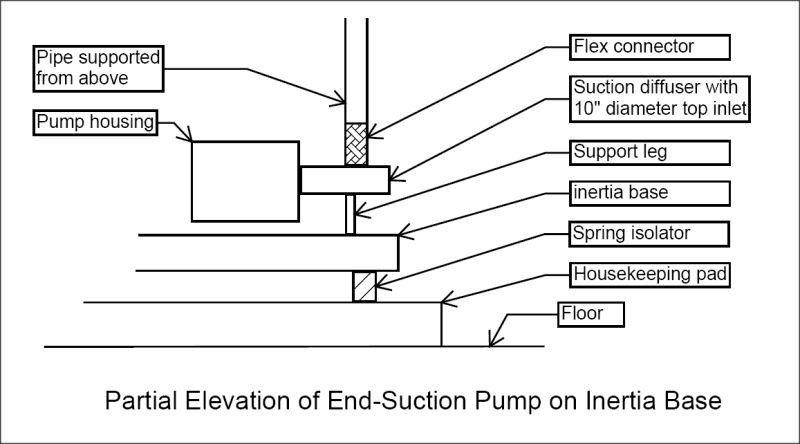mrev23
Mechanical
- Mar 20, 2014
- 26
Doesn't the force on the support leg of a suction diffuser depend on:
[ol 1]
[li]The pressure inside the housing?[/li]
[li]The size of the inlet pipe?[/li]
[/ol]
Page 11 of the instructions for installing a suction diffuser says only
Suppose all the suction piping, valves, etc., are suspended from above (not resting on the suction diffuser), and the pump assembly is on an inertia base with vibration isoloators, as shown below:

If the highest part of the piping is 60 feet above the suction diffuser, the static pressure on the inside surface of the suction diffuser is 60 / 2.31 = 26 psi.
The force due to this pressure is balanced everywhere except at the inlet, where the flex connection doesn’t transmit any vertical force.
The inside area of the inlet is ~ pi / 4 * (10-in)^2 = 78 square inches.
This suggests to me that the leg of the suction diffuser, and the spring isolators, are subjected to a load of
26 psi * 78 square inches = 2,030 pounds
due to elevation alone.
This is higher than I expected.
Am I missing something, and this load is actually much lower?
Or is this situation comparable to the force from a tee in push-fit piping system, such as ductile iron, on a thrust block? This force from a tee is illustrated in Figure 4 on page 6 of this file:
[ol 1]
[li]The pressure inside the housing?[/li]
[li]The size of the inlet pipe?[/li]
[/ol]
Page 11 of the instructions for installing a suction diffuser says only
Be aware of water weight in the Suction Diffuser Plus and connected piping when
installing your system.
installing your system.
Suppose all the suction piping, valves, etc., are suspended from above (not resting on the suction diffuser), and the pump assembly is on an inertia base with vibration isoloators, as shown below:

If the highest part of the piping is 60 feet above the suction diffuser, the static pressure on the inside surface of the suction diffuser is 60 / 2.31 = 26 psi.
The force due to this pressure is balanced everywhere except at the inlet, where the flex connection doesn’t transmit any vertical force.
The inside area of the inlet is ~ pi / 4 * (10-in)^2 = 78 square inches.
This suggests to me that the leg of the suction diffuser, and the spring isolators, are subjected to a load of
26 psi * 78 square inches = 2,030 pounds
due to elevation alone.
This is higher than I expected.
Am I missing something, and this load is actually much lower?
Or is this situation comparable to the force from a tee in push-fit piping system, such as ductile iron, on a thrust block? This force from a tee is illustrated in Figure 4 on page 6 of this file:
